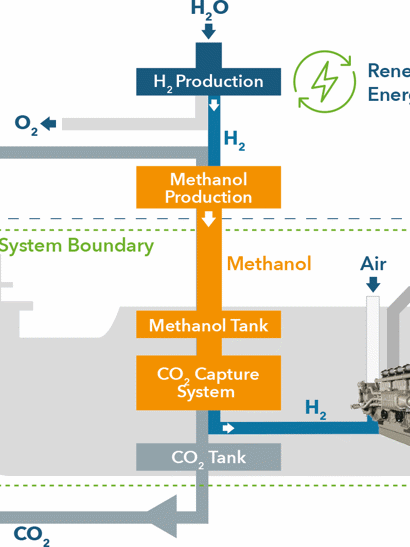The Hydrogen-Methanol Ship propulsion system using on-board pre-combustion carbon capture project aims to drastically reduce emissions and improve the efficiency.
Scope:
The Hydrogen-Methanol Ship propulsion system using onboard pre-combustion carbon capture (HyMethShip) project aims to drastically reduce emissions and improve the efficiency of waterborne transport at the same time. During the three-year project durion, the HyMethShip system will not only be developed and validated but also demonstrated on shore with a typical engine for marine applications in the range of 2 MW (TRL 6). The overall budget for this collaborative project is €9.28M with a maximum European Grant of €8.43M.
The HyMethShip system will achieve a reduction in CO2 of more than 97% and will practically eliminate SOx and PM emissions. NOx emissions will be reduced by more than 80%, significantly below the IMO Tier III limit. The energy efficiency of the HyMethShip system is more than 45% better than the best available technology approach (renewable methanol as fuel coupled with conventional post-combustion carbon-capturing).
The HyMethShip system, as schematically shown below, innovatively combines a membrane reactor, a CO2 capture system, a storage system for CO2 and methanol as well as a hydrogen-fueled combustion engine into one system. The proposed solution reforms methanol to hydrogen, which is then burned in a conventional reciprocating engine that has been upgraded to burn multiple fuel types and specially optimized for hydrogen use.
The HyMethShip project will undertake risk and safety assessments to ensure that the system fulfills safety requirements for on-board use. It will also take into account the rules and regulations under development for low flashpoint fuels.
The cost-effectiveness of the system will be assessed for different ship types and operational cases. For medium and long-distance waterborne transport, the HyMethShip concept is considered the best approach available that achieves this level of CO2 reduction and is economically feasible.
The HyMethShip consortium includes a globally operating shipping company, a major shipyard, a ship classification society, research institutes and universities, and equipment manufacturers. Further stakeholders will be represented in the External Expert Advisory Board and will be addressed by dissemination activities respectively.

Work packages:
- WP1 Project management (LEC)
- WP2 Carbon capture system (SE.S)
- WP3 Methanol reforming (Fraunhofer)
- WP4 H2 (multi-fuel) IC Engine (GEJ)
- WP5 Methanol / CO2 on-board storage (Exmar)
- WP6 Safety on-board / off-board (LR EMEA)
- WP7 Economic assessment (CHALMERS)
- WP8 Environmental assessment (CHALMERS)
- WP9 Ship design / Integration of systems (SSPA)
- WP10 System demonstration (LEC)
- WP11 Dissemination, exploitation and communication (LEC)
Partners
Classification society:
- Lloyd's Register
Industry:
- GE Jenbacher GmbH & Co OG
- Fraunhofer IKTS
- SSPA Sweden AB
- SE.S
- Colibri bv
- Exmar Marine NV
- MUW Screentec GmbH
- MEYER WERFT GmbH & Co. KG
- HOERBIGER Ventilwerke GmbH & Co OG
Universities, Reseach and Technology Centres:
- LEC GmbH (Projekt koordinator)
- Technische Universität Graz
- Chalmers Tekniska Hoeskola AB






 This project has received funding from the European Union’s Horizon 2020 research and innovation programme under grant agreement No 768945
This project has received funding from the European Union’s Horizon 2020 research and innovation programme under grant agreement No 768945